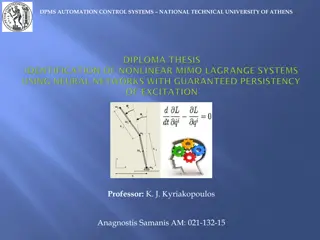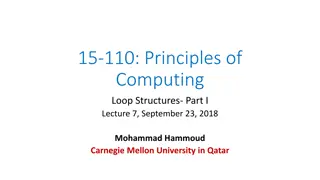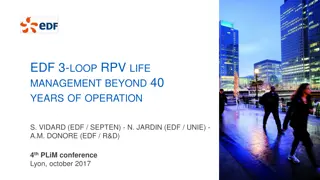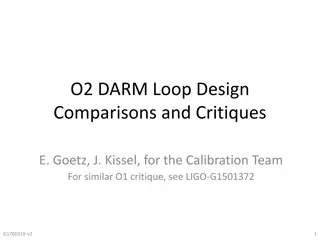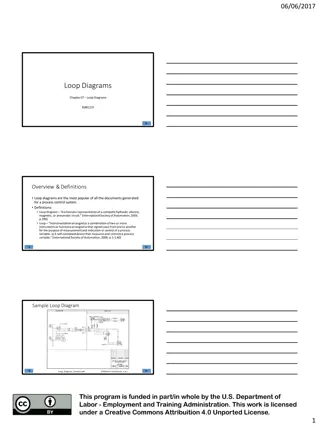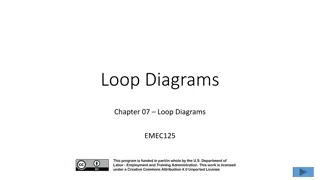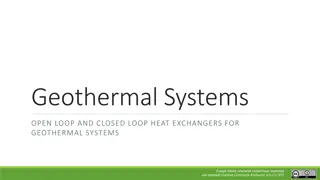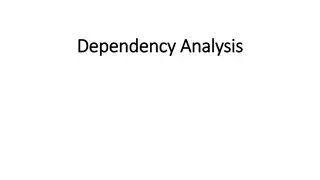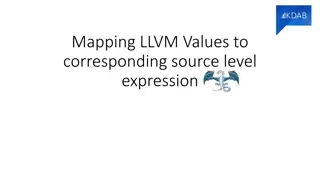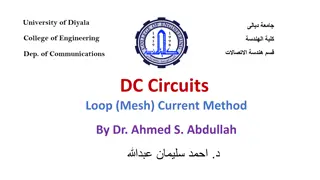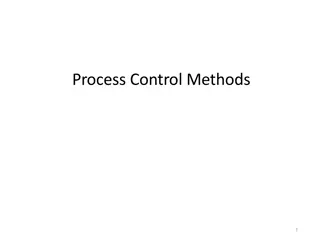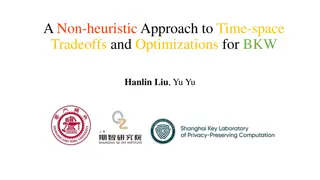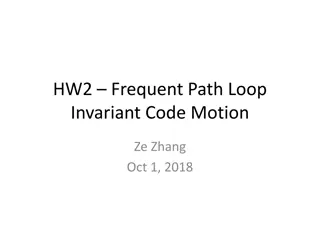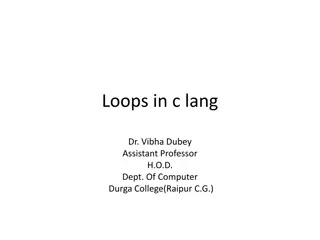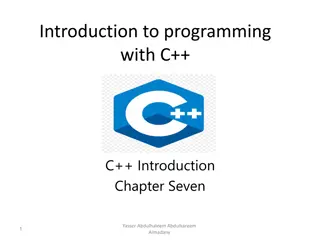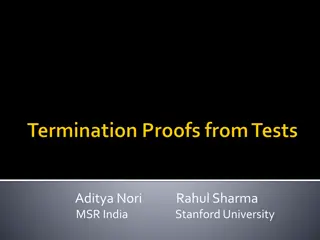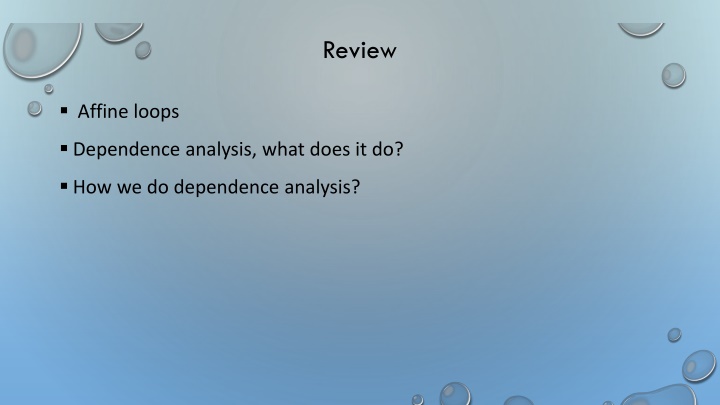
Optimizing Loop Structures in Affine Loops: An Overview
Learn about dependence analysis in affine loops and various transformations like reordering, scalar replacement, normalization, and more to optimize loop structures for improved program efficiency and locality in dependence. Explore unimodular transformations for legal loop changes.
Download Presentation

Please find below an Image/Link to download the presentation.
The content on the website is provided AS IS for your information and personal use only. It may not be sold, licensed, or shared on other websites without obtaining consent from the author. If you encounter any issues during the download, it is possible that the publisher has removed the file from their server.
You are allowed to download the files provided on this website for personal or commercial use, subject to the condition that they are used lawfully. All files are the property of their respective owners.
The content on the website is provided AS IS for your information and personal use only. It may not be sold, licensed, or shared on other websites without obtaining consent from the author.
E N D
Presentation Transcript
Review Affine loops Dependence analysis, what does it do? How we do dependence analysis?
Reordering transformation A reordering transformation preserves a dependence if it preserves and relative execution order of the source and sink of the dependence. Any reordering transformation that preserves every dependence in a program preserves the semantics of the program Loop optimization: Finding the reordering transformation that preserves all dependence in the program while achieving better locality! o Find all dependence distance/direction vector in the loops, make sure that the transformations preserves all of them.
Scalar replacement of array elements for (i=0; i<N; i++) for(j=0; j<N; j++) for (k=0; k<N; k++) c(i, j) = c(i, j) + a(i, k)* b(k, j); Scalar replacement allows registers to be allocated to the scalar, which reduces memory references. o Registers are almost never allocated to array elements. for (i=0; i<N; i++) for(j=0; j<N; j++) { ct = c(i, j) for (k=0; k<N; k++) ct = ct + a(i, k)* b(k, j); c(i, j) = ct; } Notice in the example that ct creates loop carried dependence.
Loop normalization Make the loop index variable starts from 1 (or 0) with a step of 1. for (i=a; i<b; i+= c) { // loop body } It does not do too much by itself. But it simplifies the iteration space and makes it easier to manipulate, which enables other optimizations. for (ii=1; ii<(b-a)/c; ii++) { i = a + (ii-1) *c; // loop body }
Loop transformations Change the shape and direction of loop iterations o Change the access pattern Increase data reuse (locality) Reduce overheads o Valid transformations need to maintain all loop carried dependence. o Unimodular transformations Loop interchange, loop permutation, loop reversal, loop skewing, and many others o Loop fusion and distribution o Loop tiling o Loop unrolling
Unimodular transformations A unimodular matrix is a square matrix with all integral components and with a determinant of 1 or 1. Let the unimodular matrix be U, it transforms iteration ? = ?1,?2, ,?? to iteration U ?. A unimodular transformation represented by matrix U is legal when applied to a loop nest with a set of distance vector D if and only if for each d in D, Ud >= 0. Distance vector tells the dependences in the loop.
Unimodular transformations: loop interchange for (i=0; i<n; i++) for (j=0; j < n; j++) a(i, j) = a(i-1, j) + 1; for (j=0; j<n; j++) for (i=0; i < n; i++) a(i,j) = a(i-1, j) + 1; Distance vector = [1, 0] 1 0 1 0 1 1 0 = = = = D U UD 0 1 0 1 0 0 1 Ud >= 0, the transformation for this loop nest is legal.
Unimodular transformations: loop permutation for (i=0; i<n; i++) for (j=0; j < n; j++) for (k=0; k < n; k++) for (l=0; l<n; l++) // loop body for (k=0; k<n; k++) for (l=0; l < n; l++) for (i=0; i < n; i++) for (j=0; j<n; j++) // loop body 0 0 1 0 0 0 1 0 1 i 3 i 0 0 0 1 0 0 0 1 2 4 i i = = = U U 1 0 0 0 1 0 0 0 3 1 i i 0 1 0 0 0 1 0 0 4 2 i i
Unimodular transformations: loop permutation for (i=0; i<n; i++) for (j=0; j < n; j++) for (k=0; k < n; k++) for (l=0; l<n; l++) // loop body for (k=0; k<n; k++) for (l=0; l < n; l++) for (i=0; i < n; i++) for (j=0; j<n; j++) // loop body How to derive U? ?0,0 ?1,0 ?2,0 ?3,0 ?0,1 ?1,1 ?2,1 ?3,1 ?0,2 ?1,2 ?2,2 ?3,2 ?0,3 ?1,3 ?2,3 ?3,3 ? = How to derive U? 0 0 1 0 ?0,0? + ?0,1? + ?0,2? + ?0,3? ?1,0? + ?1,1? + ?1,2? + ?1,3? ?2,0? + ?2,1? + ?2,2? + ?2,3? ?3,0? + ?3,1? + ?3,2? + ?3,3? ?0,0 ?1,0 ?2,0 ?3,0 ?0,1 ?1,1 ?2,1 ?3,1 ?0,2 ?1,2 ?2,2 ?3,2 ?0,3 ?1,3 ?2,3 ?3,3 ? ? ? ? ? ? ? ? ? ? ? ? 0 0 0 1 = U = = ? = 1 0 0 0 0 1 0 0 Hence, ?0,0? + ?0,1? + ?0,2? + ?0,3? = ? ?0,2 = 1, ?0,0 = 0, ?0,1 = 0, ?0,3 = 0
for (int i = 0; i<n; i++) for (int j=0; j<n; j++) for (int k=0; k<n; k++) { S1: a[i+1][j][k-2] = a[i][j][k] + 1; S2: a[i+1][j-1][k+2] = c[i][j][k] + d[i][j][k]; } Is this legal? Distance vectors for the loop [1, 0, -2], [1, -1, 2], and [0, 1, -4]. for (int k = 0; k<n; k++) for (int i=0; i<n; i++) for (int j=0; j<n; j++) { S1: a[i+1][j][k-2] = a[i][j][k] + 1; S2: a[i+1][j-1][k+2] = c[i][j][k] + d[i][j][k]; }
UNIMODULAR TRANSFORMATIONS: LOOP REVERSAL for (i=0; i<n; i++) for (j=0; j < n; j++) a(i,j) = a(i-1, j) + 1.0; for (i=0; i<n; j++) for (j=n; j >=0; i--) a(i,j) = a(i-1, j) + 1.0; 1 0 1 = U = d 0 1 0 1 0 1 1 = = Ud 0 1 0 0
UNIMODULAR TRANSFORMATIONS: LOOP SKEWING for (i=0; i<n; i++) for (j=0; j < n; j++) a(i) = a(i+ j) + 1.0; for (i=0; i<n; i++) for (j=i+1; j <i+n; j++) a(i) = a(j) + 1.0; 1 0 = U 1 1
Loop fusion Takes two adjacent loops that have the same iteration space and combines the body. oLegal when there are no flow, anti- and output dependences in the fused loop. oWhy Increase the loop body, reduce loop overheads Increase the chance of instruction scheduling May improve locality for (i=0; i<n; i++) a(i) = 1.0; for (j=0; j<n; j++) b(j) = 1.0 for (i=0; i<n; i++) { a(i) = 1.0; b(i) = 1.0; }
Loop distribution Takes one loop and partitions it into two loops. for (i=0; i<n; i++) { a(i) = 1.0; b(i) = a(i); } oWhy Reduce memory trace Improve locality for (i=0; i<n; i++) a(i) = 1.0; Increase the chance of instruction scheduling for (i=0; i<n; i++) b(i) = a(i)
Loop tiling Replacing a single loop into two loops. for(I=0; I<n; I++) for(I=0; I<n; I+=t) for (ii=I, ii < min(I+t,n); ii++) T is call tile size; N-deep nest can be changed into n+1-deep to 2n-deep nest. for (i=0; i<n; i++) for (j=0; j<n; j++) for (k=0; j<n; k++) For (i=0; i<n; i+=t) for (ii=I; ii<min(i+t, n); ii++) for (j=0; j<n; j+=t) for (jj=j; jj < min(j+t, n); jj++) for (k=0; j<n; k+=t) for (kk = k; kk<min(k+t, n); kk++)
Loop tiling When using with loop interchange, loop tiling create inner loops with smaller memory trace great for locality. Loop tiling is one of the most important techniques to optimize for locality o Reduce the size of the working set and change the memory reference pattern. For (i=0; i<n; i+=t) for (ii=I; ii<min(i+t, n); ii++) for (j=0; j<n; j+=t) for (jj=j; jj < min(j+t, n); jj++) for (k=0; j<n; k+=t) for (kk = k; kk<min(k+t, n); kk++) For (i=0; i<n; i+=t) for (j=0; j<n; j+=t) for (k=0; k<n; k+=t) for (ii=I; ii<min(i+t, n); ii++) for (jj=j; jj < min(j+t, n); jj++) for (kk = k; kk<min(k+t, n); kk++)
LOOP TILING EXAMPLE For (i=0; i<160000; i++) for (j=0; j<160000; j++) a[i][j] = b[i][j] + c[i][j]; For (i=0; i<10000; i+=16) for (j=0; j<10000; j+=16) for (ii=I; ii<16; ii++) for (jj=j; jj<16; jj++) a[ii][jj] = b[ii][jj] + c[ii][jj]; The inner loop has a small memory footprint and may Fit in L1 cache.
Loop unrolling Reduce control overheads. for (i=0; i<100; i++) a(i) = 1.0; Increase chance for instruction scheduling. for (i=0; i<100; i+=4) { a(i) = 1.0; a(i+1) = 1.0; a(i+2) = 1.0; a(i+3) = 1.0; } Large body may require more resources (register). This can be very effective!!!!
Loop optimization in action Optimizing matrix multiply: for (i=1; i<=N; i++) for (j=1; j<=N; j++) for(k=1; k<=N; k++) c(i, j) = c(i, j) + A(i, k)*B(k, j) o First look: memory references -- c(i, j), A(i, 1..N), B(1..N, j) Spatial locality: memory reference stride = 1 is the best What is the default storage scheme in C/C++? Row major or Column major? When you flatten the 2 dimension array by yourself (using pointer arithmetics), you can use any storage scheme as you see fit. Row major or Column major, either A array or B array has a bag pattern! Temporal locality: hard to reuse cache data since the memory trace is too large.
Loop optimization in action Initial improvement: increase spatial locality in the inner loop, references to both A and B have a stride 1. Transpose A before go into this operation (assuming row-major storage). Compare the speed of lect7/my_mm.c, method 0 and method 1 Transpose b /* for all i, j, w(i, j) = b(j, i) */ For (i=1; i<=N; i++) for (j=1; j<=N; j++) for(k=1; k<=N; k++) c(i, j) = c(i, j) + a(i, k)*w(j, k)
Loop optimization in action C(i, j) are repeatedly referenced in the inner loop: scalar replacement (method 2) Transpose b for (i=1; i<=N; i++) for (j=1; j<=N; j++) { t = c(i, j); for(k=1; k<=N; k++) t = t + a(i, k)*b(j, k); c(i, j) = t; } Transpose b for (i=1; i<=N; i++) for (j=1; j<=N; j++) for(k=1; k<=N; k++) c(i, j) = c(i, j) + a(i, k)*b(j, k)
Loop optimization in action Inner loops memory footprint is too large: A(1..N, i), B(1..N, i) Loop tiling + loop interchange Memory footprint in the inner loop A(1..t, i), B(1..t, i) Using blocking, one can tune the performance for the memory hierarchy: Innermost loop fits in register; second innermost loop fits in L2 cache, Method 4 for (j=1; j<=N; j+=t) for(k=1; k<=N; k+=t) for(I=1; i<=N; i+=t) for (ii=I; ii<=min(I+t-1, N); ii++) for (jj = j; jj<=min(j+t-1,N);jj++) { t = c(ii, jj); for(kk=k; kk <=min(k+t-1, N); kk++) t = t + A(kk, ii)*B(kk, jj) c(ii, jj) = t }
Loop optimization in action Loop unrolling (method 5) for (j=1; j<=N; j+=t) for(k=1; k<=N; k+=t) for(I=1; i<=N; i+=t) for (ii=I; ii<=min(I+t-1, N); ii++) for (jj = j; jj<=min(j+t-1,N);jj++) { t = c(ii, jj); t = t + A(kk, ii) * B(kk, jj); t = t + A(kk+1, ii) * B(kk+1, jj); t = t + A(kk+15, ii) * B(kk + 15, jj); c(ii, jj) = t } This assumes the loop can be nicely unrolled, you need to take care of the boundary condition.
Loop optimization in action Instruction scheduling (method 6) + would have to wait on the results of * in a typical processor. * is often deeply pipelined: feed the pipeline with many * operation. Effective for older machine, no longer effective on the current linprog. for (j=1; j<=N; j+=t) for(k=1; k<=N; k+=t) for(I=1; i<=N; i+=t) for (ii=I; ii<=min(I+t-1, N); ii++) for (jj = j; jj<=min(j+t-1,N);jj++) { t0 = A(kk, ii) * B(kk, jj); t1 = A(kk+1, ii) * B(kk+1, jj); t15 = A(kk+15, ii) * B(kk + 15, jj); c(ii, jj) = c(ii, jj) + t0 + t1 + + t15; }
Loop optimization in action FURTHER LOCALITY IMPROVE: BLOCK ORDER STORAGE OF A, B, AND C. (METHOD 7) FOR (J=1; J<=N; J+=T) FOR(K=1; K<=N; K+=T) FOR(I=1; I<=N; I+=T) FOR (II=I; II<=MIN(I+T-1, N); II++) FOR (JJ = J; JJ<=MIN(J+T-1,N);JJ++) { T0 = A(KK, II) * B(KK, JJ); T1 = A(KK+1, II) * B(KK+1, JJ); T15 = A(KK+15, II) * B(KK + 15, JJ); C(II, JJ) = C(II, JJ) + T0 + T1 + + T15; } 1 4 0 2 3 5 7 6 8 Each block is a 16x16 sub-matrix

